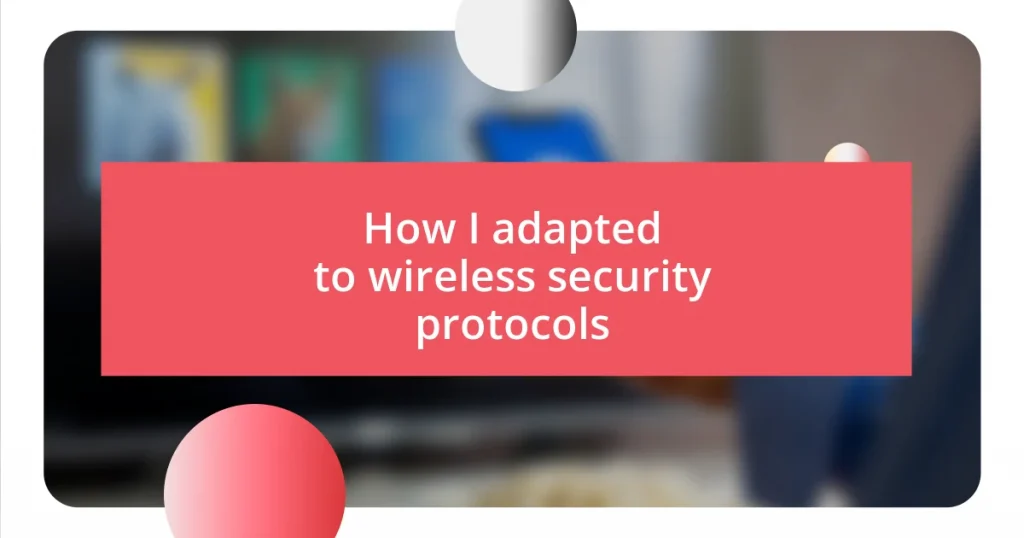Key takeaways:
- WPA2 and WPA3 offer significant enhancements in wireless security, providing better protection for personal data compared to older protocols like WEP and WPA.
- Regularly updating and monitoring security protocols is essential to protect against evolving threats, ensuring devices stay secure from vulnerabilities.
- Implementing strong passwords and segmenting the network can significantly boost overall security, minimizing risks associated with less secure devices like smart home gadgets.
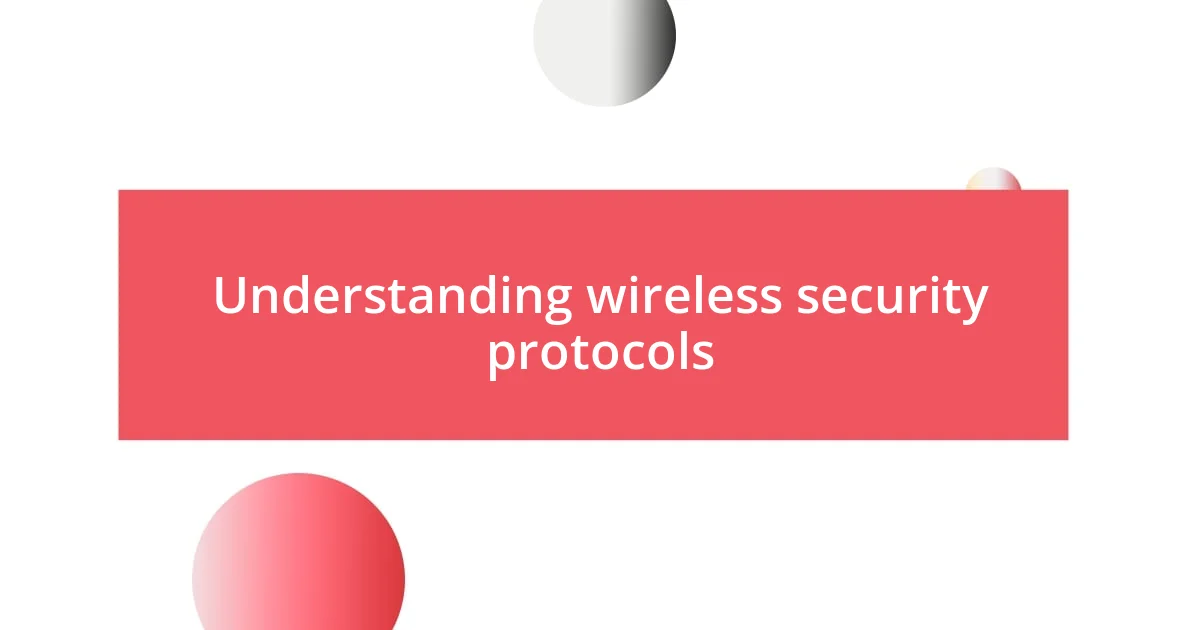
Understanding wireless security protocols
Wireless security protocols are crucial for protecting our personal data while using networked devices. I still remember the first time I connected to a public Wi-Fi hotspot, filled with excitement but also a twinge of anxiety. Was my information safe? This concern is common, as these protocols play a significant role in ensuring that our communications remain private and secure from prying eyes.
Diving deeper into the specifics, I discovered that protocols like WEP, WPA, and WPA2 each serve different levels of security. Personally, I found WPA2 to be a game changer for my home network. It completely transformed my sense of security—I could finally stream videos and work online without constantly checking over my shoulder, so to speak.
As I navigated through various networks, I became aware of the technical jargon—encryption, SSID, and authentication methods. These terms initially felt intimidating, but understanding them opened a new perspective on wireless security. Have you ever wondered how these protocols genuinely protect your information? It’s fascinating to think about the complexity behind the scenes that keeps our digital lives safe.
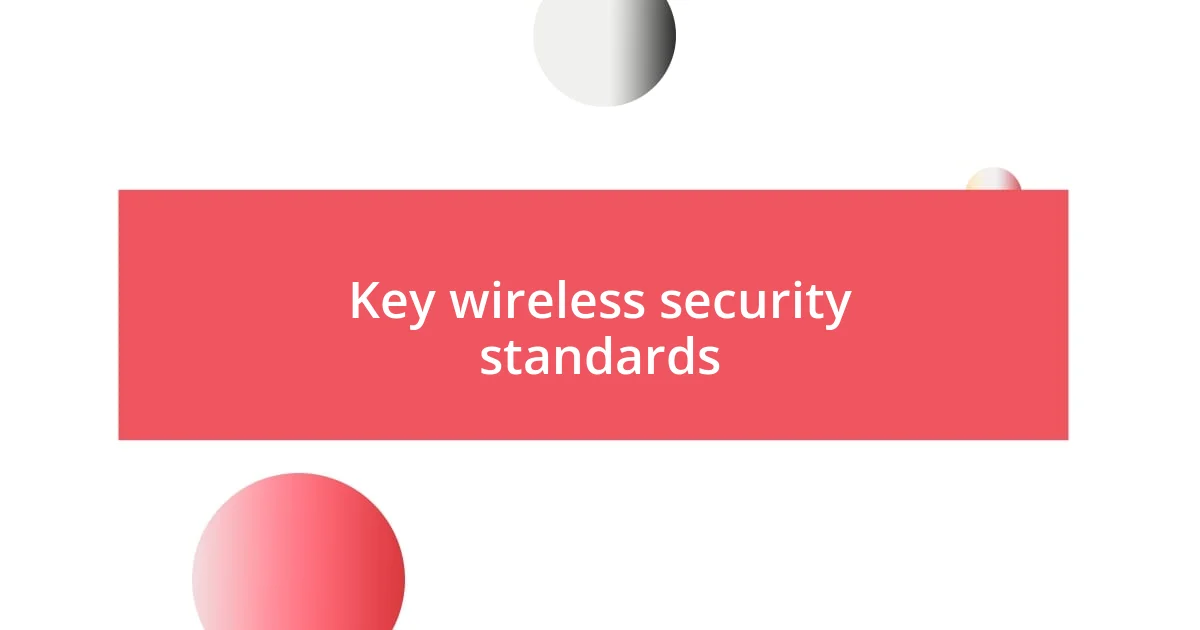
Key wireless security standards
Understanding key wireless security standards is like discovering a treasure map in the world of cybersecurity. Each standard offers different layers of protection, helping us navigate safely in a digital landscape filled with potential threats. When I first learned about the advancements in wireless security, it felt like a weight was lifted off my shoulders. I could finally appreciate how these protocols work together to safeguard my personal information.
Here are some of the key wireless security standards to know:
- WEP (Wired Equivalent Privacy): The first standard implemented but now considered outdated due to significant vulnerabilities.
- WPA (Wi-Fi Protected Access): Developed to improve security over WEP by incorporating stronger encryption methods but still has limitations.
- WPA2: An enhancement of WPA providing even better security through AES (Advanced Encryption Standard) encryption, which I’ve used for my home Wi-Fi, feeling much safer compared to WEP or WPA.
- WPA3: The newest standard with improved security features, making it harder for attackers to crack passwords, offering peace of mind when connecting to various networks.
I vividly recall when I switched to WPA2 on my router. I felt a mixture of relief and empowerment, as if I had fortified my digital fortress. The thought of my data being secure—whether I was online shopping or simply browsing social media—transformed my online experience into a trusted one. It’s a beautiful feeling when technology works to protect what matters most to you.
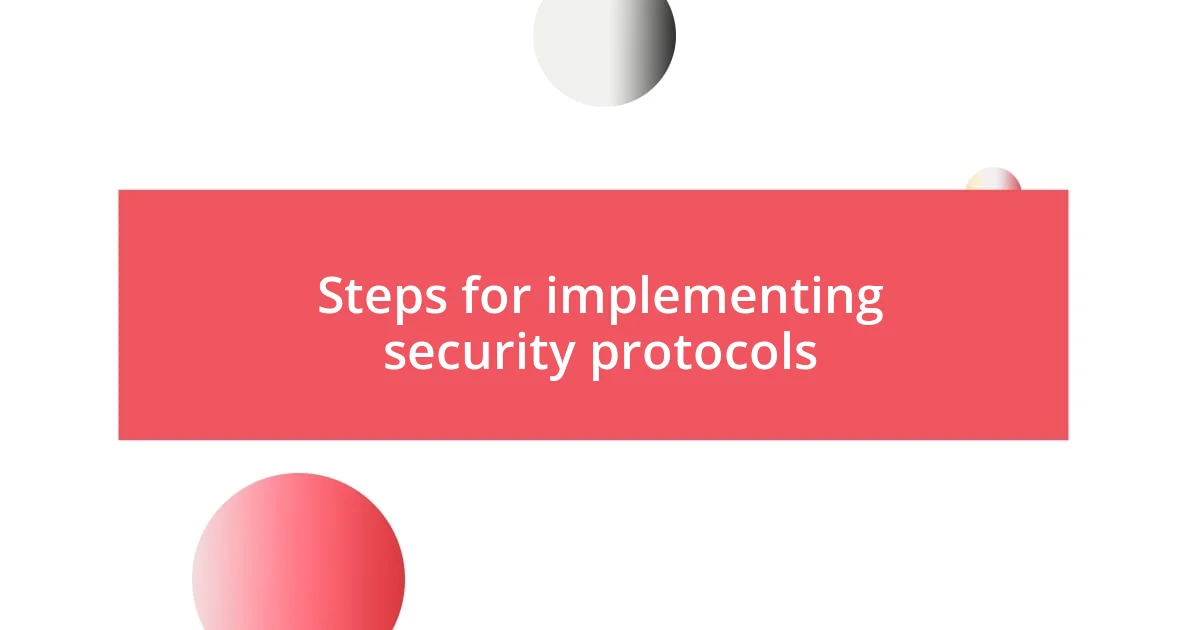
Steps for implementing security protocols
Implementing security protocols is a systematic process, and it begins with assessing your specific needs. I recall when I first decided to secure my network; I asked myself, “What do I need to protect?” Identifying the sensitivity of my data propelled me toward stronger measures. This self-analysis is vital in determining which protocols will best suit your situation.
Once you’ve established your needs, the next step is to choose and configure the appropriate protocols. For me, switching to WPA3 was a crucial moment. It felt like I was finally utilizing the best tools at my disposal—no more second-guessing my network’s safety. Configuring these settings can be technical, but I found plenty of online resources that guided me through the process seamlessly.
Finally, continuous monitoring and updating of security protocols are essential. I once overlooked this task and faced a scare when an unknown device connected to my network! Regularly checking and updating settings ensures that you’re not just secure today, but also prepared for tomorrow’s threats. It’s about creating a habit—a routine that keeps you one step ahead of potential vulnerabilities.
| Step | Description |
|---|---|
| Assess Needs | Identify what data you need to protect and choose the level of security you require. |
| Choose Protocols | Select and set up the most suitable wireless security protocols based on your assessment. |
| Monitor and Update | Regularly review your network’s security status and update protocols to meet evolving threats. |

Common challenges in adaptation
Adapting to wireless security protocols comes with its fair share of challenges. One common hurdle I faced was understanding the technical jargon surrounding these standards. The abbreviations like WEP, WPA, and AES felt overwhelming at first. I remember staring at my router’s settings, questioning if I should even attempt the configuration. It took time and patience, but by breaking down each term and researching its implications, I gradually built my confidence in navigating through this complex landscape.
Another obstacle I encountered was compatibility issues with older devices. When I upgraded to WPA3, I was excited but soon discovered that some of my gadgets couldn’t connect anymore. It was frustrating, as I had to weigh the benefits of enhanced security against the inconvenience of having to replace or update devices. I often found myself asking: is increased security worth a temporary slowdown in daily convenience? Ultimately, I realized that prioritizing cybersecurity was more significant than clinging to outdated technology.
Finally, ensuring consistent updates and monitoring was a continuous struggle. After a couple of months of feeling secure, I became complacent and ignored the updates. Then, out of the blue, I got an alert about a vulnerable access point. The fear of potential breaches jolted me back to reality. This experience reinforced the idea that security isn’t a one-time task; it’s an ongoing commitment. It made me appreciate the importance of staying vigilant—are you prepared to face the evolving threats, or will you let your guard down like I did?
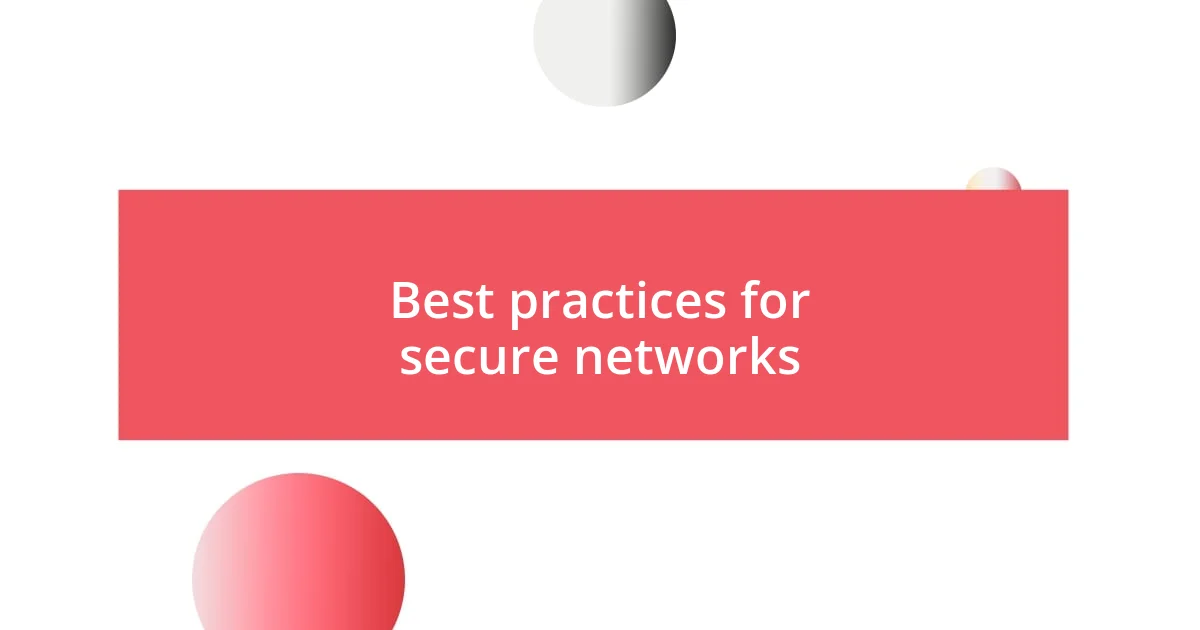
Best practices for secure networks
Best practices for secure networks involve a thoughtful approach that I’ve refined over time. One of the first things I do is ensure that my router’s firmware is always up to date. I remember the anxiety I felt after hearing about remote access vulnerabilities due to outdated software. By regularly checking for updates, I not only reduce the risk of breaches but also gain access to new features that can further enhance my network’s security.
In addition to keeping software updated, I strongly advocate for utilizing strong passwords—think a mix of letters, numbers, and special characters. Initially, I used simple passwords, believing they were sufficient. It was a wake-up call when I realized how easily someone could crack even minor security measures. Now, I use a password manager to generate and store complex passwords, and I routinely change them. This practice has significantly boosted my peace of mind.
Another best practice I’ve embraced is segmenting my network. I learned the hard way that having all devices on one network created unnecessary risk—especially with smart home devices that have less robust security. I’ve set up a separate network for those gadgets, which not only limits potential breaches but also keeps my primary devices safer. Have you considered how a simple change in your network structure could enhance your overall cybersecurity? It’s a small step that pays off in the long run.
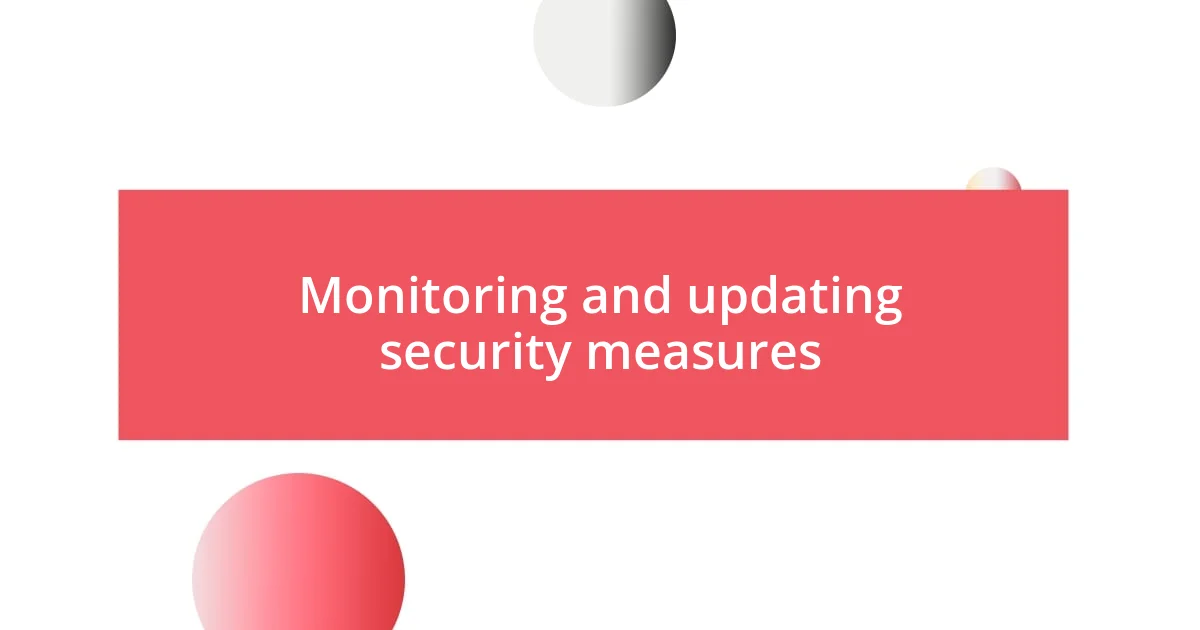
Monitoring and updating security measures
Monitoring security measures is crucial, and I can’t stress enough how often it saved me from potential disasters. After experiencing my first security alert, I learned to embrace a proactive monitoring system. I set up notifications for any suspicious activity on my network, which created a sense of security. It felt almost like having a digital guardian watching over my home, ready to alert me of any strange occurrences.
As I became more comfortable with these protocols, I started making it a habit to review my settings monthly. During one of these check-ins, I discovered a device I thought was deactivated had somehow reconnected to my network. It was a stark reminder of how technology can sometimes slip through the cracks. This experience led me to ask: Have you accounted for every device on your network lately? These regular checks not only help in identifying threats but also give me an opportunity to fine-tune my security measures.
Updating security measures as new threats emerge can feel daunting, but I’ve made it a ritual. Whenever I hear about new vulnerabilities in wireless security protocols, I immediately dive into research. I vividly recall feeling a wave of apprehension when news broke about a major WPA2 vulnerability. I updated my software the same day, and it was reassuring to know that I was taking preventive action. Are you updating your security regularly, or are you simply hoping for the best? In my experience, staying a step ahead makes all the difference in safeguarding my digital life.










